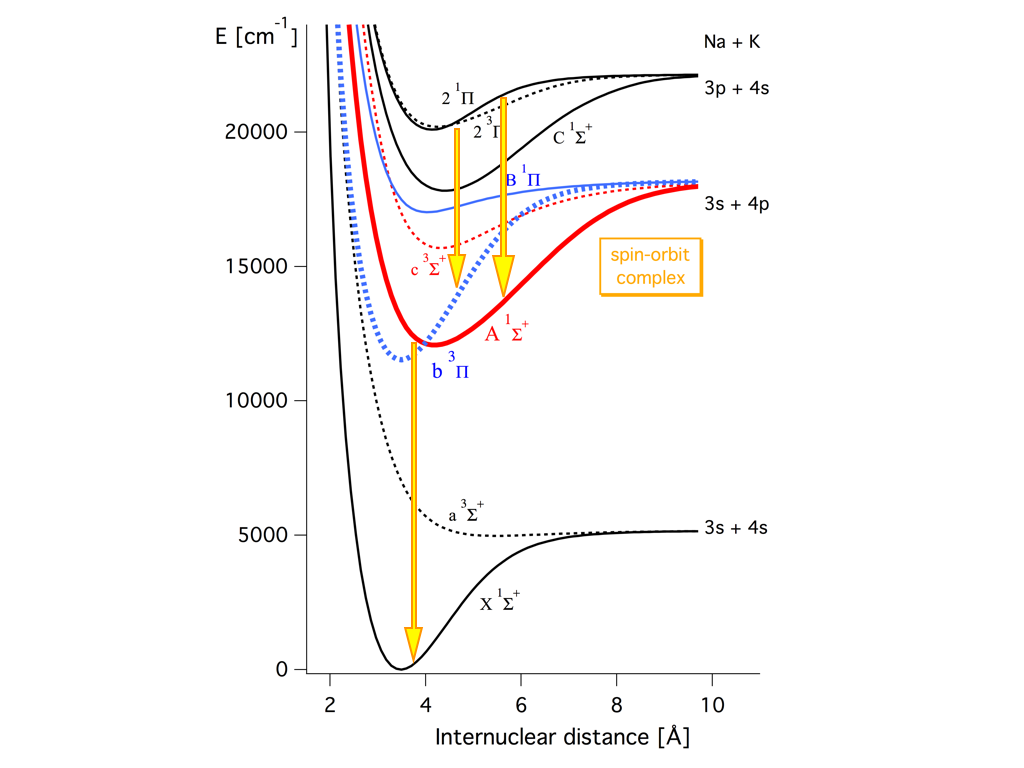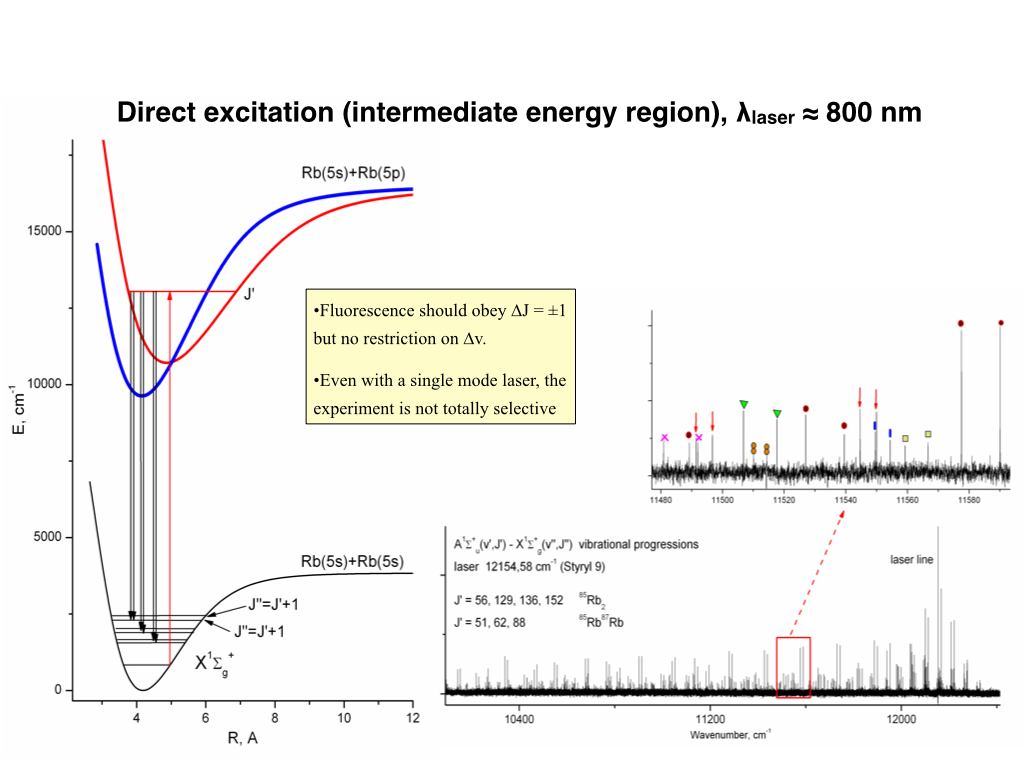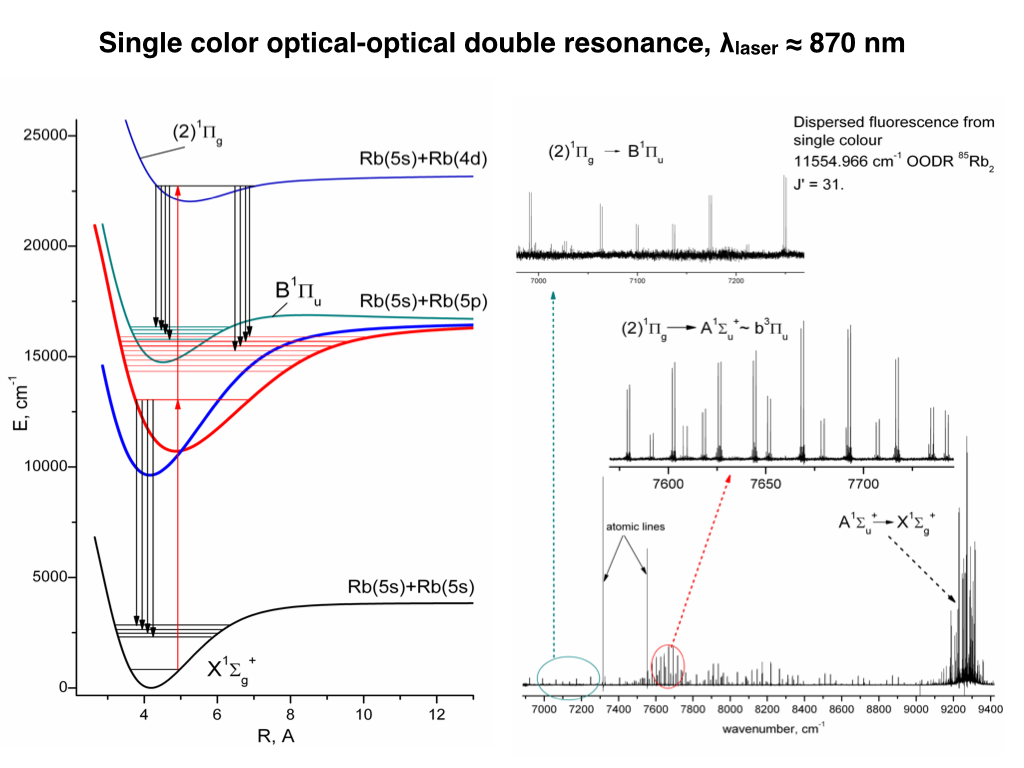High Resolution Spectrometry of Alkali Dimers
A. ROSS, P. CROZET, H, HARKER

Fig 1. Molecular potential energy curves pertaining to NaK, but also typical of other alkali dimers, which show fluorescence relative to the spin-orbit complex.
Laser-induced fluorescence (LIF) coupled to Fourier transform spectrometry (FTS) is particularly well-adapted to the study of alkali dimers, for which precise measurements provide the framework necessary for ultra-cold experiments and also serve as benchmarks for asymptotic models of chemical bonds developed notably by the physical-chemistry theoretical group at the ILM. Indeed, first homonuclear and more recently dipolar alkali dimers have been identified as prime candidates for cold atom, photoassociation (PAS) experiments. PAS experiments preferentially probe highly excited vibrational levels, also accessible using our techniques, that are difficult to identify without prior knowledge of the electronic structure. In the case of alkali dimers, this structure is often quite complexe and its description through potential energy curves V(R), perhaps coupled via matrix elements, requires a precise and reliable accounting of spin effects among others.
Our approach is therefore to study alkali dimer electronic states by coupling 1- and 2-photon Laser-induced fluorescence techniques with Fourier transform spectrometry (LIF-FTS). The experimental setup while fairly simple, gives rise to rich, rotationally resolved spectra, since working conditions favor collisional energy transfer. Selective excitation of a single rovibronic state via a longitudinal, monomode laser allied with the precision and resolution of Fourier spectrometry, allows us to decipher these complex spectra, unattainable using direct absorption experiments. Furthermore, electronic excitation, using the 2-photon scheme (pump + spontaneous emission) gives access to 'gerade' vibronic levels of centrosymmetric species, unaccesible via direct absorption.
Our studies focus on the highly irregular regions of the electronic spectra of both homonuclear and heteronuclear alkali dimers, in particular of Rb2 et NaK. The spectral perturbations that render usual molecular quantum number assignments difficult , if not altogether impossible, arise from the strong spin-orbit coupling in these molecules. Still, numerical methods allow us to solve the Schrödinger radial equation for these systems. We have devised strategies that allow use of analytical forms for the molecular potential energy curves and for the spin-orbit coupling functions. We use molecular appropriate Hamiltonians to perform coupled-state calculations, taking into account not only spin-orbit perturbations, but also the effects of spin-rotation coupling, by using finite difference numerical techniques and collocation methods. This method was successfully tested on published NaK data and also on experimental data pertaining to the strongly coupled pair of excited electronic states, A 1Σ(u)+ and b 3Σ(u)+, in Rb2. Models reaching experimental precision (Doppler limited) have been obtained using molecular potential energy curve parameters and spin-orbit coupling functions optimized through iterative, non-linear least squares fitting. Results are verified by study of isotopic substitution effects and modeling of observed intensities.
NaK :
 Figure 2 : LIF-FTS spectrum of the A 1Σ+ - X 1Σ+ system in NaK with a zoom on vibrational relaxation that allowed observation of three, successive avoided crossings in the vA = 0 of the A 1Σ+ electronic state of NaK, in interaction with b 3Π.
Figure 2 : LIF-FTS spectrum of the A 1Σ+ - X 1Σ+ system in NaK with a zoom on vibrational relaxation that allowed observation of three, successive avoided crossings in the vA = 0 of the A 1Σ+ electronic state of NaK, in interaction with b 3Π.
Similar scientific complexities are found in both homo- and heteronuclear alkali dimers, yet the spin-orbit effects, while present in NaK, do not completely mask the spectral vibrational patterns (cf Figure 2) as with Rb2. We collaborate with Professor Thomas Bergeman of Stony Brook University, USA, an expert in use of the DVR method for treating systems perturbed by spin-orbit effects. In particular, we recently recorded and exploited ~80 LIF-FTS spectra of the A 1Σ+ / b 3Π ← X 1Σ+ band system in NaK, providing the Term energies necessary for the analytical fitting of this pair of electronic states using the DVR method and for fitting of the spin-orbit coupling functions. Since the energies we obtain are referenced to the non-perturbed, ground electronic state, the goal of these experiments was two-fold : to augment and fill critical holes in the existing data set, while simultaneously referencing each of its entries to the electronic ground state. Indeed, a substantial data set pertaining to NaK has existed since the 80’s, but has remained until now difficult to exploit, since measurements at that time were made between two perturbed electronic states. The 4-channel DVR method currently employs ~3400 independent Term energies (Tred < 16000 cm-1), and arrives at a non-weighted standard deviation of 0.025 cm-1, roughly ~3x measurement precision.
The renewal of these detailed studies of the NaK energy structure is largely motivated by molecular cooling experiments that are initiated through weakly bound molecules, called “Feshbach” molecules. The cooling of these molecules, typically of dominant triplet character, is strongly facilitated by 2-photon transfer through an intermediate excited electronic state of mixed singlet/triplet character, such as the spin-orbit coupled A 1Σ+ / b 3Π states in NaK, before accessing the X 1Σ+ electronic ground state. Reliable prediction of efficient optical transition for molecular cooling requires detailed knowledge of the electronic potential energy curves and matrix coupling elements, over a broad range of internuclear distances. Our work focuses on developing appropriate forms of these matrix elements. Future 2-photon experiments will allow much more numerous observations of the b 3Π triplet electronic state, whose direct access from the ground electronic state is forbidden by spin selection rules.
Rb2 :
Double resonance experiments using two monomode lasers were used to systematically probe the 2 1Πg state of Rb2, producing fluorescence towards the B 1Πu et A1Σu+/b 3Πu electronic states. Given a sufficiently long excited state lifetime, the level selected by optical pumping can depopulate through collissions, transferring population to neighboring rotational, and even rovibrational and rovibronic, states. The resulting spectra describe the pumped excited state all the better, and can reveal effects that might otherwise go unobserved. Anomalies in the intensities of only a few transitions are the result of quantum interference effects, caused in this case by local avoided crossings (spin-orbit perturbations). Our models for V(R) and μ(R) (electric transition dipole moment) must necessarily reproduce both the molecular energies and measured intensities of the dispersed fluorescence. Research pertaining to even more excited electronic states continues in collaboration with Poland (IF - PAN & Univ. Varsovie) using polarisation spectroscopy and with the USA (Temple University, Philadelphia, USA), perfecting techniques that allow privileged access to triplet states.
 Fig 4 : Fluorescence following direct excitation of the suivant l'excitation of the A 1Σ+u - X 1Σ+g band system in Rb2, which illustrates spectral complexity and only partial selectivity despite use of a monomode laser.
Fig 4 : Fluorescence following direct excitation of the suivant l'excitation of the A 1Σ+u - X 1Σ+g band system in Rb2, which illustrates spectral complexity and only partial selectivity despite use of a monomode laser.

Fig 5 : Fluorescence following single color, optical-optical double resonance excitation of the 2 1Πg - A 1Σ+u - X 1Σ+g band system in Rb2, illustrating enhanced spectral purity due to more selective excitation. The double resonance approach is clearly more appropriate for the study of the 2 1Πg et A1Σu+/b 3Πu electronic states, using the already known B 1Πu state as an energetic reference.

















